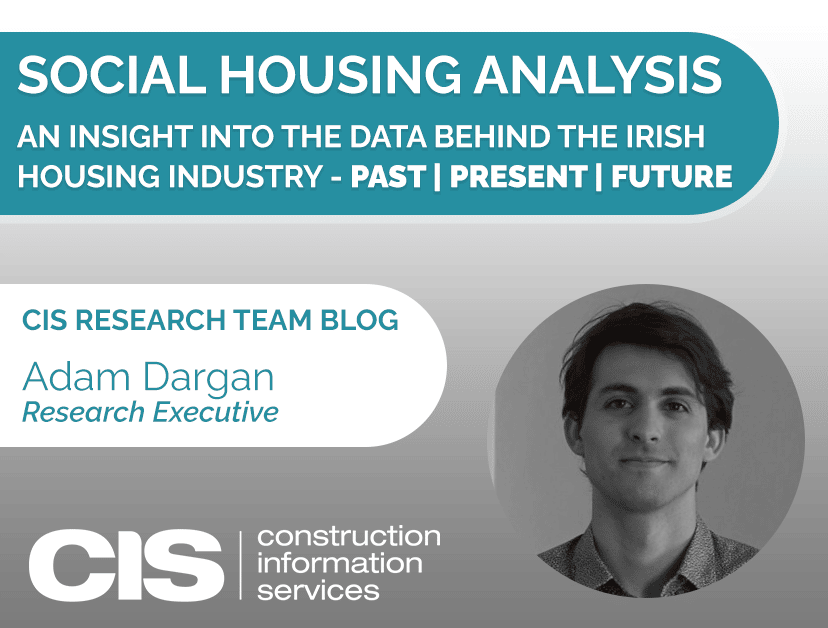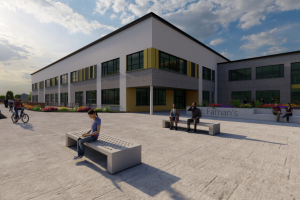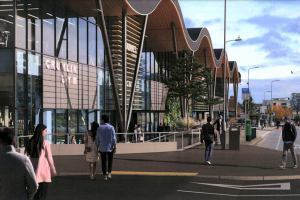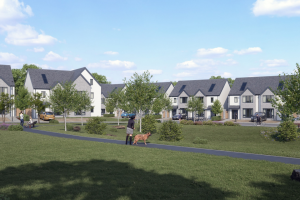Social housing in 2022 has become a popular topic for construction and government alike. Headlines in the news for the last several months paint a picture as to the ongoing sentiment about the state of construction for social housing in Ireland. This blog aims to combine this data with CIS’s own data to provide insights into potential opportunities in the near future.

In July of 2021 the LDA and Dún Laoghaire-Rathdown County Council have planning permission to build 546 apartments and 51 houses at Shanganagh, south of Shankill Village.
The successful bidder is expected to be selected later this year with construction scheduled to start next year and with the first homes due to be completed early in 2023.
Of the 597 homes, 200 will be used for social housing, 91 will be sold to low and middle-income workers under the forthcoming affordable scheme, and 306 will be cost-rental homes, where the rent is based on the cost of financing, building and managing the housing.
In August of 2021 the new State body responsible for developing housing projects on State-owned land has suffered a setback to one of its first major schemes. The Land Development Agency has been refused permission to build more than 200 new homes at a former Army barracks in Co Kildare.
An Bord Pleanála has rejected an application by the agency to develop 221 social and affordable homes on the site of the former Devoy Barracks in Naas.
The board said the plans had provided insufficient car-parking spaces for a development that did not have high-frequency public transport connections. The site on the John Devoy Road is adjacent to the headquarters of Kildare County Council, close to Naas town centre.
Alongside its concerns about the lack of parking spaces, the board said the development would be “dominated to an unacceptable degree” by surface car parking that would run contrary to guidelines for urban housing projects.
The Government is advancing plans to transfer some 1,400 social housing units to the Land Development Agency (LDA) from the National Asset Management Agency (Nama) in a move that will secure State ownership of the homes. The transfer to the LDA, which comes as Nama winds down its operations, will also enable it to back the expansion of social housing over time. Minister for Housing, Local Government and Heritage, Darragh O’Brien TD, today (27th August, 2021) visited the construction site of the Ashline social housing development in Ennis, which will see the provision of 40 social housing units through a direct build scheme by Clare County Council.

In September of 2021 South Dublin council votes to sell public land for development of 620 homes
A motion to dispose of council land in Killinarden, in southwest Dublin, to build 620 homes has been passed by local councillors despite abstentions from Sinn Féin members and opposition from two other representatives. The deal involves the sale of nearly 16 hectares in Killinarden, Tallaght, to developer Arden for €14 million in exchange for the development of nearly 500 social and affordable homes.
The development will be 60% affordable purchase, 20% private homes and 20% social housing, which will be owned by South Dublin County Council.

The Government aims to deliver 300,000 new homes by the end of 2030 under the €4 billion-per-year Housing for All plan to be unveiled today.
The plan to ramp up supply in a bid to finally tackle the housing crisis will also include a pledge to end homelessness by the end of the decade. The Cabinet is to provide the final sign-off on the plan today before Minister for Housing Darragh O’Brien will formally launch it alongside Taoiseach Micheál Martin, Tánaiste Leo Varadkar and Green Party leader Eamon Ryan.
Almost 90,000 of the homes to be delivered are to be social housing, with a target of a further 36,000 affordable properties over the next nine years. Another 18,000 homes will be designated cost rental, where rents will be at least 25 % below the market rate.
The Land Development Agency (LDA) will take a lead role in creating a large-scale affordable cost-rental sector in Ireland, a key element of the Government’s Housing for All strategy published yesterday.
The strategy contains a range of important measures to support the LDA’s twin-track approach of accelerating near term construction of affordable homes on both state and private land, whilst also working over the longer term to assemble large state-owned landbanks capable of delivering thousands of new homes.
NARPS: 1,400 social housing units owned by NAMA through its National Asset Residential Property Services (NARPS) entity will transfer to the LDA. This provides certainty of remaining under state ownership for these homes, and the prospect of LDA using this scheme to support further social housing investments
Complex construction projects take time, but we are on track to commence construction of our first homes next year, and the combination of the passage of the LDA Act over the summer, and the publication of Housing For All yesterday, means that the LDA is now positioned to make a major positive impact on Ireland’s housing problems”
The LDA’s overall strategy is guided by 5 key principles:
- Affordable: Increasing supply of affordable housing to deliver a fair deal for those who don’t qualify for social housing but cannot afford the private market
- Stable Supply: Ensuring a long-term pipeline of delivery from state-owned assets to provide a counter-cyclical mechanism that will deliver new homes even in an economic downturn where private-sector delivery slows, thereby reducing the tendency towards ‘boom-bust’ cycles
- State Land: Using state land more efficiently to avoid the burden of land costs and operate at scale to deliver new homes at a lower cost
- Community: Offering security of tenure and high-quality amenities so that residents in LDA developments become an integrated part of the local community
- Sustainability Ensuring a best-in-class approach to sustainable construction methods and maximizing public transport access and open space
In October of 2021 ‘Demanding’ five-year social housing targets issued to councils
More than 9,000 social homes expected to be built in Dublin city. Dublin City Centre has been issued with a construction target of 9,087 homes from 2022-2026. Demanding targets for the construction of more than 47,000 social homes over the next five years have been issued to local authority chief executives across the State.

Almost 20% of the 47,600 homes are designated for Dublin city, a target which would require social housing construction in the capital to increase by almost 10 times the current rate. Councillors in all local authorities will be briefed in the coming weeks on the individual targets for new homes to be built by their local authorities or housing bodies in their jurisdiction.
The other three Dublin local authorities are between them expected to deliver another 18% of the national total. South Dublin County Council has been issued with a construction target of 3,380 homes. A similar target of 3,287 homes has been issued to Fingal County Council, while Dún Laoghaire-Rathdown County Council has a target of 1,996 homes.
Under the Government’s Housing for All plan published last month an average of 9,500 new social homes are to be provided annually State-wide.
Building skills shortage may check Coalition plans on homes
The Government faces steep hurdles from a construction skills shortage and rising prices for building materials after setting aside a record €5.5 billion for housing in the budget, industry participants have warned.
Minister for Housing Darragh O’Brien has said the budget measures “will ensure” the Government can meet ambitious targets to boost the construction of new homes and settle the housing crisis that is its greatest policy challenge after the pandemic.
However, individuals involved in priority social housing projects and private developments warned of increasing strain in the sector as public investment ramps up in a bid to assert control over a surging rents and purchase prices.
Major developers have cast doubt over Dublin City Council’s housing targets, calling into question the potential to deliver the scale of new homes needed to tackle the housing crisis. Developers have also called for proposed curbs on build-to-rent apartments schemes to be scrapped, in submissions made as the planning regulator moved to block such restrictions being introduced.
The developers’ views were set out in voluminous submissions to the council on its 2022-28 draft development plan, which will set a parameter for building in the city for the rest of the decade.
Almost 1,500 submissions published by the council include papers from companies controlled by figures such as Sean Mulryan, Johnny Ronan and Michael O’Flynn and builders such as Glenveagh and Castlethorn.
In March of 2022 the Republic needs 400,000 new homes over the next decade to tackle its housing crisis, Stephen Garvey, chief executive of builder Glenveagh Properties warned on Tuesday.
Mr Garvey spoke after Glenveagh said that it earned pre-tax profits of €45.7 million last year, turning around a €15.7 million loss in 2020.
“I would say that Ireland needs 400,000 units over the next decade, and that’s across every front,” said Mr Garvey.
He added that this should include homes for first-time buyers, students and social and affordable housing. State bodies such as the Central Bank of Ireland calculate that the Republic should build 30,000 to 35,000 homes a-year over the same period to house its growing population.
However, Mr Garvey argued that this did not take “latent demand” into account. He noted that builders completed 20,000 dwellings in 2020, which did not meet the likely 30,000-plus demand. He further warned that developments granted permission under a new planning scheme, for projects with 100 or more houses, could get end up in court unless Government shakes up policy.
Government initiated the Large Residential Development scheme in March this year
The scheme requires builders to seek permission from local councils for big housing projects, rather than An Bord Pleanála, but provides for speedy appeals against planners’ decisions. Its predecessor, the fast-track strategic housing development initiative, gave An Bord Pleanála responsibility for schemes of 100-plus properties.
However, plans for more than 11,000 homes given the go-ahead under that scheme now face High Court challenges. The new law, planning policy and the Government’s own aims, set out in last year’s Housing for All report, must be aligned, Mr Garvey stressed.

Social housing projects at risk unless councils can pay developers more, the Government has been warned.
The amount which councils could spend on housing construction ‘needs to be examined’, as new social housing projects risk being jeopardised unless local authorities are allowed to pay developers more. Despite overall completions on the rise when compared to the same period last year – likely due to the pandemic.
The future of Social Housing
Social housing developments are dependant on the market and generally cannot be dissociated from the construction industry in its entirety. However, there has certainly been more emphasis on it in the last few years as can be seen in the completed projects from the CIS database. Despite worldwide disruptions, due to Covid and Brexit to a lesser extent, there has actually been an increase in the completed projects over the period of 2019 to 2021. Along with the steady inflow of planning submissions the sentiment is there will be more and bigger social housing schemes continuing going forward. The only question is how much will supply chain, material costs, the LRDs vs SHDs and budget limits affect the ability of the government to follow through on the promises the make for the next few years.
With ongoing supply chain issues worldwide construction in Ireland has been slowed. This cascades into a rise of costs for materials leading to new tenders needing to be made as contractors are not able to make profit with ever increasing costs to build. There has also been a labour issue caused by the pandemic and will not be remedied in the short term. The replacement of the Strategic Housing Development (SHD) scheme with the new Large Residential Developments (LRD) has firmly placed any large-scale building into the hands of local councils instead of An Bord Pleanála.
It remains to be seen as to which scheme will be more effective, however the potential for high court cases may decrease which could in fact make these schemes move to an on-site phase earlier than the SHD’s. Finally, the last hurdle may be a self-imposed one by the government with budgets not reflecting a practical approach to construction given all the previous issues mentioned. If the trend of more completed projects is a good indicator than I think we may see a rise in social housing construction in the short to midterm future.
Please do not hesitate to contact me at [email protected] if you have any questions about this report.
By clicking here or emailing [email protected], you can also join up for a no-obligation free trial of CIS Online.








 Download CIS reports by clicking the button below.
Download CIS reports by clicking the button below.